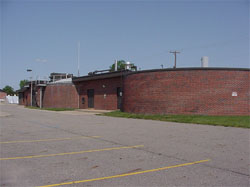
Delhi's old digesters are on the way out.
A mid-Michigan wastewater treatment plant worker once discovered what happens when a sewage digester gets an upset stomach.
“He sat down to have a cup of coffee and he looked at the window and it was black,” said Jeff Ranes, manager of the Delhi Township plant near Lansing. “That thing actually blew its seal around the lid.”
Sludge ran through the plant’s parking lot, but a quick cleanup prevented any contamination, he said.
But that shouldn’t happen anymore. The township recently wrapped up construction on a set of new digesters, part of $10 million project that will increase the plant’s capacity while generating electricity and producing clean “biosolids.”
Biosolids is a fresh name for nutrient-rich wastewater leftovers often applied to farm fields as fertilizer.
The plant will be the first in the country running generators on new digester technology, said Sandra Diorka, Delhi’s director of public services.
The feat earned the township one of seven awards that federal officials gave to innovative wastewater projects in Great Lakes states.
The projects recognized by the Environmental Protection Agency include a plan to fight industrial phosphorus in Minnesota and to keep sewage out of Pennsylvania stream.

State and federal regulations limit the biosolids from Delhi’s old digesters to use on crops that will feed livestock, and the township has to pay to have the biosolids hauled away. But the new system will make a cleaner product that could earn the township money, Ranes said.
One potential customer is a local municipal utility looking to meet renewable energy goals by replacing coal, Diorka said.
“We are talking to the Lansing Board of Water and Light to partner with them to do research on actually using the dried solids as a fuel source for their power plants,” she said.
The new digester system will also generate some power of its own. While breaking down sludge, the bacteria naturally produce methane gas. Diorka said the plant has just been burning that gas off for the past 30 years.
But the methane from the new digesters will fuel two 30-kilowatt electrical generators, producing about enough energy to power the digester process.
“We’re not just going to be wasting the gas by burning it off to the atmosphere,” Ranes said. “Its actually going to go toward something good.”
What’s more, the exhaust from the generators will keep the digesters heated to the precise temperatures the bacteria need to function.
The new system should save the township $75,000 a year in energy and natural gas bills, Diorka said.
The plan got its legs when the township, Michigan State University and other technology partners applied for a grant from the 21st Century Jobs Fund, the state’s $2 billion program to create high-tech jobs.
They didn’t get the grant, but the township board was excited about the project and the plant still needed new digesters, so they went ahead with it anyway, Diorka said.
In 2007, the township got a $500,000 grant and a $9.85 million low-interest loan from the Michigan Department of Environmental Quality. The township’s loan came at a 1.65 percent interest rate, said Cindy Cledenon, a project manager for the state department.
If the township had borrowed money on the open market, it might have had to pay 5 or 6 percent interest, Diorka said.
Ranes said the digestion process uses two species of bacteria that break down sludge. One produces an acid, while the other turns the acid into methane gas. The old digesters keep both species in one tank.
While the two species usually work at the same pace, Ranes said a few days of extra sludge can speed up the acid producers. The methane producers can’t convert the acid to gas fast enough, which upsets the digester.
The new digesters, which separate the bacteria into different tanks, will be more forgiving, he said.
Clendenon said the state’s low-interest loan program often has more loan requests than it can fund, and the $236 million boost the program got from the federal stimulus act is only making matters worse.
“This year we’re getting totally overloaded because everybody wants a piece of the stimulus money,” she said.